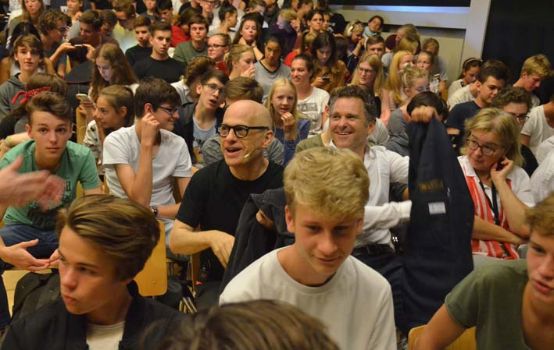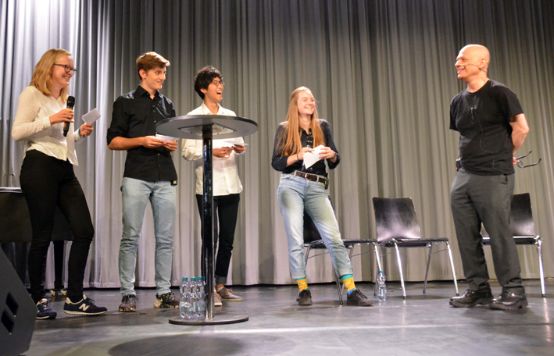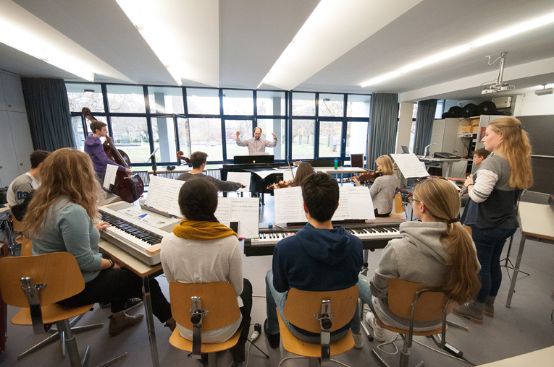An "innovative project" falls apart
On March 14 and 15, the Kantonsschule Alpenquai Luzern celebrated its anniversary with a world premiere together with the Lucerne Symphony Orchestra. However, the commissioned work "harmony and understanding" by David Lang turned out to be rather one-dimensional.

The advance praise was immense, ranging from "star composer", "exceptional", "innovative" to "creative and groundbreaking". And the artistic director of the Lucerne Symphony Orchestra (LSO), Numa Bischof-Ullmann, who was jointly responsible for his orchestra's "education project", said confidently: "I am proud that we were able to win David Lang for the joint project", because he is a true world star.
Something very special was planned for the 50th anniversary of the Kantonsschule Alpenquai Luzern (KSA). The well-known American composer David Lang (*1957) wanted to create a work that would involve not only the orchestra but also the 1500 pupils of the school as well as the entire audience at the premiere venue, the concert hall of the Culture and Convention Center Lucerne (KKL). "A concert in which the audience becomes a protagonist is an experiment," explained KSA Vice Principal Stefan Graber.
Graber and his colleague Stefano Nicosanti were responsible for coordination: "Kanti Alpenquai is daring to experiment in the knowledge that this is a central task of grammar school education: an open, curious approach to the unfamiliar and new." He also emphasized the valuable collaboration with the LSO: "Both parties bring tradition, innovation and contemporaneity into a critical and enriching conversation."
Underchallenged young people
High expectations were raised. Unfortunately, this is not always an advantage, as harmony and understanding at the premiere. Even the arrival in front of the KKL did not bode well, as cantonal students stood there discussing the preparations: "That was definitely for the foxes," was the unanimous opinion.
Before the performance, the audience, who were involved, had to practise first. The instruction by conductor André de Ridder and co-conductor Elena Kholodova, choir director at the cantonal school, lasted no less than 50 minutes. Quite a long time, considering that there were 750 Kanti students in the audience who had already practiced in the presence of David Lang days before.
The work is in three parts: In the first part, entitled "In the forest", the audience had to whisper the alphabet, while the orchestra played soft tremolo strings in the style of minimal music and cheering bells rang. Then horns joined the fray, while the audience was asked to answer questions about their origins. Under the guidance of de Ridder and Kholodova, quiet murmuring was at least slightly varied with crescendos and decrescendos.
It continued in this style. In the second part, the audience had to "sing" a "melody" consisting of just eight notes played by the orchestra "as in a carnival", and at the end there was a murmur of Esperanto words, a language that everyone understands. However, the utopian content and didactic orientation of the work came to nothing.
You could see students chatting with each other, schoolgirls fiddling with their cell phones or looking bored into the KKL circle. It was obvious that the young people were underchallenged. The evening lasted far too long, as Antonín Dvořák's Symphony No. 8 was played after the obligatory speeches, but only at 9.45 pm, when the audience's concentration had long since been exhausted.
-

- Photo: Benno Bühlmann
- September 5, 2017, students of the Kantonsschule Alpenquai Luzern interview David Lang in English.
Preliminary work as a benefit
Not everything failed. This is particularly true of the wide-ranging preparation. Students performed the work with Elena Kholodova on December 3, 2017 Just by David Lang from the movie Youth on. Encounters with the composer were also part of the overall project: four cantonal students were able to interview him in English at a podium.
The in-depth approach to Dvořák's Symphony No. 8 was also interesting. Pupils specializing in music were allowed to be present from the very first orchestra rehearsal. This resulted in interesting texts that were printed in the concert program. Music teacher Martin Bucheli also worked on the 4th movement of the work with a school ensemble, whereby the score, which actually requires an 80-piece orchestra, had to be reduced to 16 parts. Bucheli writes about this in the program booklet: "Although all the pupils attend instrumental lessons, there is no one who plays the bassoon, oboe, viola, piccolo flute, trombone or trumpet. Instead, there are several singers and pianists in the class. So I had to replace the missing original instruments with electric pianos or synthesizers." The result was obviously worth listening to, at least Bucheli was "amazed at how close we got to the original sound".
-

- Photo: Markus Wild
- Music teacher Martin Bucheli experimentally explores Dvořák's 8th Symphony with his class, with each pupil playing a voice adapted for this self-experiment on their usual instrument - a powerful shared musical experience in the sense of "harmony and understanding".








